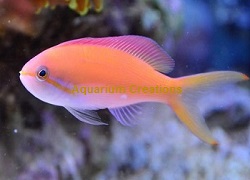Aquarium Conditioned
Carberryi Anthias
Nemanthias carberryi

Identification:
The Carberryi anthias is a stunning fish from the reefs of Maldives, also known under the name Threadfin Anthias. The Carberryi Anthias is one of the smaller Anthias species with a max size of 3 inches. Carberryi Anthias have a mostly pink body with strong orange highlights and a yellow tail. Male Carberryi Anthias tend to be more colorful as well. In the wild they are often found in groups of thousands of fish. In the aquarium they are best kept in groups with one male and several females. They can sometimes have a hard time acclimatizing to a new aquarium. The presence of another anthias species can make the process easier.
Tank Recommendations:
To keep a shoal of Carberryi Anthias, you will need an aquarium of 100 gallons or more. An aquarium of 60-gallons is sufficient for a solitary Carberryi Anthias. Requires rockwork to swim through and hide in.
Food and diet:
Anthias are planktivores and feed primarily on zooplankton, tiny animals found in the water column. They benefit from several small feedings throughout the day rather than one large feeding. The best feeding for anthias will come from a healthy microinvertebrate population in your aquarium with a constant supply of copepods and amphipods available for food. Having a refugium attached to your aquarium makes the proper supply of food available any time through the steady supply of live food sure to keep any planktivore content. What should you be feeding your anthias? You have to add meaty foods (finely shaved seafood, frozen Cyclops, fish eggs and carnivore foods) at least three times a day. If you do not feed enough food, it will become more and more emaciated and will gradually perish.
Level of Care:
Moderate
Acclimaton Time:
3+ hours
Reef Compatibility
: Excellent
Approximate Purchase Size:
Small: 1-1/4" to 2"; Medium: 2" to 3"; Large: 3" to 4"
|
Small$79.99
Medium $79.99
Large $99.99
|
|

